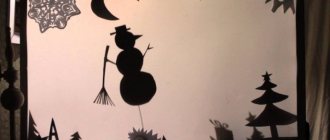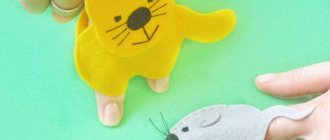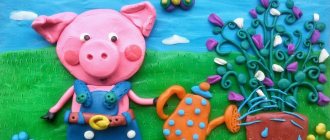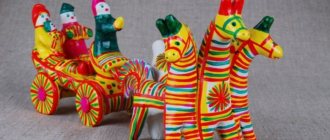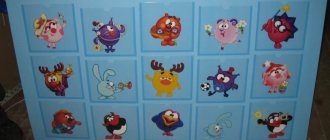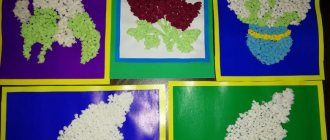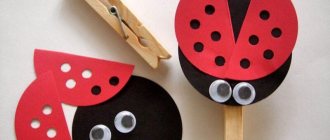Positive aspects of creativity
Crafts made from waste bring great benefits and give pleasure to all participants in the process. Here are the main advantages of DIY crafts made from recycled materials, which are not always obvious:
- children learn to come up with unexpected uses for old things and throwaway products, which teaches them to be economical and environmentally friendly;
- you don’t have to spend money on expensive consumables, especially when there is a shortage of funds and the high cost of delivery to remote residential areas;
- everything can be done at home, with a minimum of funds;
- imagination, creativity, and non-standard thinking develop;
- You can have a fun and enjoyable time in rainy or winter weather.
Construction is a universal skill that is important to develop at a very early age. If parents, educators and teachers involve children in this process, they can count on the comprehensive creative development of children.
DIY crafts made from recycled materials for school will be an important factor in promoting neatness and thrift.
Materials
What can you use for DIY waste crafts? Any things that are not needed will be used, even the most non-standard options:
- cardboard boxes of all sizes;
- glass and plastic bottles;
- containers for food or chocolate, kinder surprises;
- computer disks, records;
- candy wrappers, foil, beautiful pictures, postcards;
- old magazines;
- foam rubber and polystyrene;
- plugs, caps;
- buttons, beads, fringe, sequins.
It is important that the materials are clean, bright and intact; you should not take old and worn-out items.
Craft materials
As a creative material you can use:
- plastic bottles and their caps of different colors and sizes;
- plastic plates, cups, forks, spoons, containers;
- traditional “natural material” - acorns, chestnuts, leaves, sticks, shells, plant seeds, pebbles, shells, etc.;
- various remnants of fabrics, beads, ribbons, braid, rhinestones, yarn, colored threads, etc.;
- traditional “children’s” materials: colored paper, cardboard, glue, colored pencils, felt-tip pens….
The list of materials used can be continued almost endlessly. In the skillful hands of masters and craftswomen there is a use for absolutely everything.
Stages of creation
If you are working on a creative recycled craft project with your child, try to instill in him the habit of thinking freely, but constructively, in accordance with the logic of the process. The stages of work can be as follows:
- The idea of creating a new toy. You can take a ready-made example as a basis, choose from a picture or photograph. Analyze with your child the features of the chosen option - what is the complexity, what materials are needed, what parts are the main ones.
- Consider the design details - fastenings, reliability of connections, safety of glue.
- Check the availability of coloring materials (markers, pencils, paints), if necessary, as well as decorations.
- Consider techniques that will be convenient and useful: modeling, applique, embroidery.
- Prepare the material and start cutting, cutting, sewing and planing parts.
- Engage in fastening the parts, check the strength of the connections.
- The finished product can be demonstrated to an audience, analyzed and discussed with children.
Show your child how to do this or that technique so that he gradually masters it and begins to work independently. Explain what needs to be done and why at each stage. In this way, children will learn to plan the entire process, have a holistic perception of work, and will more accurately strive for results.
Important: do not criticize children if something does not work out, otherwise the joy of participating in a creative project will disappear.
It is worth considering the age of the children; there is no need to expect too much from little masters. To prevent them from getting bored, it is important to encourage them and praise them for every successful step.
Goals of learning to create crafts from waste material in kindergarten, specific tasks and techniques
Waste construction is a productive activity based on creative modeling using a wide range of non-traditional materials to give new life to the world of things that are usually thrown away.
The main goals of designing from waste material are the development of children's creative, intellectual and artistic abilities, as well as environmental education.
By making a variety of crafts (toys, furniture, vehicles), children learn to find unexpected uses for specific waste materials: plastic bottles and plates, containers for Kinder surprises, lids, corks, computer disks, packaging boxes, candy wrappers, polystyrene foam, foam rubber, etc. .
By making a variety of crafts, children learn to find unexpected uses for specific waste materials.
In the process of children constructing crafts from waste materials, teachers strive to achieve the following tasks:
- Three to four years: introduce children to the interesting possibilities of unusual materials (foam rubber, polystyrene foam, plastic bottles, etc.);
- learn to use plasticine, glue, wire, threads, etc. to connect parts and pieces;
- develop fine motor skills.
- develop cognitive and research activities;
- teach children to coordinate their actions in the process of collective work;
By creating original crafts from waste materials, children develop creative thinking.
Techniques for teaching design from waste material are traditionally built on an imitative basis and have their own characteristics at different stages:
- Stage one - detailed analysis of a sample of the future product:
- in the younger group, a craft made in advance by the teacher is used as a model;
- in the middle group, children can be asked to look at a picture or drawn image;
- at the age of six, children are already able to analyze the diagram or model of a toy; the analytical activity of children includes identifying the main parts of the toy and the material from which it is made, discussing clarifying questions, for example: what material for the craft can still be considered;
- what options for fastening parts will be optimal;
- what additional techniques can be used to design details, for example, modeling from plasticine, drawing with felt-tip pens, pencils, paints or applique elements.
- Stage two - children are taught to plan and think about step-by-step progress towards a goal, and are taught a holistic perception of the entire work process. It is specified in what sequence the parts are made, from what material, and which tool will be preferable. The choice of pedagogical techniques is carried out taking into account the age of the children:
- in younger groups, the teacher demonstrates in detail all the stages of constructing a craft, accompanying it with clear and detailed comments;
- in the middle group, the teacher gradually reduces the process of full demonstration and detailed explanation, involving active work with diagrams and supporting plans in the form of schematic sketches drawn by the children themselves.
- Stage three - the method of fastening parts and parts of the structure is thought out:
- in the middle group, plasticine is used as a connecting material;
- older children use glue, thread, wire, etc.
- Stage four provides for children to independently select the necessary material and tools for work.
- Stage five - children independently cope with the entire process of making crafts, from the emergence of a mental prototype of a toy to the substantive embodiment of a creative idea. At this stage, it is important to encourage the manifestation of creative imagination and the child’s desire for independence in the process of practical implementation.
- Stage six - summing up, analysis and evaluation of finished products. It is important to find positive aspects in the work of each child, support and inspire. An excellent technique at this stage would be an exciting role-playing or theatrical game using toys made by children, this will help them feel the significance of their work.
Older preschoolers can independently cope with the process of preparing parts
Options for crafts made from garbage
Now we suggest choosing an interesting idea that will allow you to use your resources profitably. Crafts made from waste and waste materials can be very simple or of increased complexity. We will divide them into certain types according to preschool age groups to make it convenient to choose the most optimal model.
If you are an educator or teacher, you can conduct creative design classes 1-2 times a week. Modeling should not be tedious; it is an exciting process that will not leave children indifferent if it is organized correctly.
Junior group
Crafts for kindergarten from waste material for the younger group:
Candy for dolls. For these simple crafts, foil, candy wrappers, corks and caps will be useful. It will be good if the general equipment is ready: the doll will sit at the table waiting for sweets, already with cups and a samovar. At the end of the event, you can have a real tea party with sweets.
Note!
Quilling crafts: features of the working technique, step-by-step instructions and clear diagrams for beginners + ideas for creative crafts (150 photos)- Crafts made from corrugated paper: 100 photos of creative solutions for crafts + step-by-step diagrams and instructions for making your own
Crafts from foamiran: ideas for creating crafts and interesting patterns for making flowers
Magic tree. It is very interesting to assemble a real tree from scrap materials - cups, bottles, wire, tubes, mosaic barrels. Plasticine, glue, various oblong caps and tubes are relevant here. You can decorate the tree with pieces of fabric and beads that are hung on paper clips.
Spiders. Make spiders from cups or small containers, fluffy wire, attach the parts with plasticine.
Funny cacti. Cacti are made well from plastic glasses and pots; you can use toothpicks and plasticine for needles. An interesting idea is to attach a pre-drawn and cut out smile and eyes to a cactus, then it will turn out completely alive.
Middle group
Children's crafts from waste material for the middle group for slightly older children? The following design ideas will suit them:
Rattles. You can create unusual toys using bottles, Kinder surprise containers, using plasticine and small decorations here and there.
Christmas tree toys. For the New Year, you can make simple and cute decorations and beads for the Christmas tree using the appliqué and sculpting techniques.
Note!
- Crafts made from polymer clay | Step-by-step master class on creating beautiful crafts
DIY epoxy resin crafts - options for original crafts, step-by-step instructions for pouring and making them yourself
Lego crafts: step-by-step master class on creating simple DIY crafts + original versions of Lego products (photo + video)
A bouquet of flowers or a single flower made from pencil shavings, thread, rain, tinsel, ribbons.
Fish. It is very interesting to cut out fish from light foam plastic; they can be painted and added to the decor.
Doll furniture. With your children, make small interior items from cardboard, matchboxes, plastic jars, and sweet containers. You will need scissors, glue, paper, cardboard, beautiful little things for decoration, unnecessary stickers.
Parade of military equipment. Play Victory Day, build small tanks and ships from boxes, jars, buttons, lollipop holders, and various interesting unnecessary parts.
Dolls made from scraps. Make a figure out of a rag, tie knots, come up with dresses, a name for the doll, draw a face.
Note!
- Christmas crafts - how to make them yourself? 150 photos of the best themed crafts
Crafts made from stones: creative options for crafts made from stones + step-by-step instructions for making your own, methods and schemes of work
Crafts from disks: a step-by-step master class on how to create them yourself, creative ideas for crafts of varying complexity + simple patterns for beginners
Chrysanthemums. Cut the cups into vermi and glue the ends together to create a flower with lush petals.
Why is this necessary?
It is not always the case that “junk” creativity is used only for kindergarten and school exhibitions and then mercilessly destroyed. If you look at photos of crafts made from waste material on the Internet, you can simply be amazed at their diversity, beauty and practicality.
These include exclusive interior items, souvenirs, gifts - hand made is now very popular and in demand.
Senior Destad group
Crafts made from waste materials for older children and toys of a more complex level:
My house. Make an imitation of your home from boxes with appliqué, adding interesting details reminiscent of familiar interiors (curtains, lamps, beds, ladders).
Traffic light. Use matchboxes and add colored paper.
Fruit table. Cut different fruits and vegetables from foam rubber, cutting off corners and sharp edges.
Snowmen. Make rounded blanks from foam rubber and supplement them with paper elements.
Blue carriage for Gena and Cheburashka. Connect pre-made boxes-cars, make wheels from bottle caps. Paint the train or decorate the carriages with appliqué.
Snowdrops. Make flowers from sticks and candy wrappers, tying them with thread.
Boxes-typewriters. Cover different boxes with paper wheels and bodies, write the name of the car brand, add appliques and modeling.
Gymnasts. Make figures from flexible wire wrapped in PVC. Roll colored paper on top and paint the faces of the gymnasts.
City at Christmas. You can make a large-scale model of a town with towers, houses, shops. For this purpose, juice bags, spray paint, markers and glue will come in handy.
Older children
Crafts from waste material for kindergarten - the preparatory group in the garden will be able to create the following projects together with the teacher:
Musical instruments. To play musicians and create basic instruments, take yogurt cups, fishing line, wire, boxes and wooden containers.
Castle from a fairy tale. With your children, construct towers and fortress walls from plastic bottles and colored paper, and decorate finished buildings and structures.
African savanna. You can create giraffes and zebras from boxes and colored paper, coloring them with stripes with felt-tip pens.
Clowns in the circus. Cute clowns are made using candy wrappers, cardboard, thread and glue. These are very simple DIY crafts made from waste material.
Thumbelina or The Little Mermaid. The heroines of Andersen's fairy tales are also crafts made from waste materials. They come from wire frames, pieces of plastic, beads and colored hair yarn.
Space theme. Cosmonauts in spacesuits can easily get their plates and bottles out of plastic; cocktail straws and paper parts will come in handy. Don't forget to draw the country's flag on the overalls and make a cord connecting the space explorers to the rocket.
Round dance of friends. Cheerful little men, boys in pants and girls in skirts who dance in circles holding hands can be made perfectly from colored paper and juice boxes (thick cardboard is a good basis for silhouettes).
Forest babies. Any forest animals (bunnies, owls, fox cubs, bear cubs) are easily made from toilet paper rolls, which serve as a blank for the body. Heads, paws and tails can be attached with applique, details can be drawn with a felt-tip pen.
Aircraft. The model is based on a plastic bottle onto which parts are glued - wings, tail, emblems.
Royal crown. For crafts made from waste material for kindergarten, use disposable plates that can be cut in half, sew on diamond buttons, and various decorative details.
Puppet Theater named after Buratino. Create a theater stage from shipping boxes, dolls from scraps, and props from bottles and boxes. Postcards are useful to decorate the curtain; the screen can be made from corrugated paper. You can move the dolls on translucent plastic tubes that are attached to the top of their bodies.
Project “Construction from waste material with children of senior preschool age”
Irina Toshcheva
Project “Construction from waste material with children of senior preschool age”
Project : “ Construction from waste material with children of senior preschool age ”
Introduction
The problem of developing interest in design in preschool children occupies a significant place in preschool pedagogy . Since a variety of constructive creativity gives children the opportunity not only to explore the world around them, but also to comprehensively develop their abilities. The relevance of the problem of conducting design classes in preschool institutions is that at this stage of the development of society, fewer hours are devoted to design children than other disciplines (language, mathematics , drawing, etc.)
Construction in the learning process is a means of deepening and expanding the acquired theoretical knowledge and developing creative abilities and inventive interests.
construction itself (from the Latin construo - I build, create)
denotes construction in general, bringing various objects, parts, elements into a certain relative position and the process of creating a model, machine, structure, technology with the implementation of
projects and calculations .
Children's design refers to the process of constructing buildings, such structures , which provide for the relative arrangement of parts and elements, and methods for connecting them. As a rule, the design takes place in the form of a game in order to interest the preschooler .
Children's artistic creativity from waste material allows them to develop not only artistic taste and creative imagination, but also forms the foundations of ecological culture.
The world of things around us is very diverse. These are plastic bottles, corks, cases, boxes, buttons, beads, etc.
We adults try to quickly get rid of it and throw it away , but it turns out that these items can be given a second life if you invest imagination and imagination and teach this to children.
An already used bottle item is not thrown away, but is turned into a useful item or craft.
The task of an adult is to reveal the creative potential of each child, to teach him to feel a sense of satisfaction from the result of his work.
There is one step from a craft to a work of art.
Purpose: To study the possibility of using waste material in working with preschool children .
Tasks:
Educational
— Introduce children to waste materials .
— Develop the ability to follow oral instructions.
— Teach various techniques for working with waste material .
— Introduce children to basic geometric concepts: circle, square, triangle, angle, side, vertex, etc. Enrich the child’s vocabulary with special terms.
— Create compositions with products made using the origami technique.
Educational:
— Develop fine motor skills, hand coordination, eye control.
— Develop attention, memory, thinking and imagination.
— Develop artistic taste, creativity and imagination of children.
— Develop spatial imagination.
Educational:
— Cultivate interest in designing from waste materials .
— Expand children’s communication abilities.
— Form a work culture and improve work skills.
— Contribute to the creation of play situations, expand children’s communication abilities.
— Encourage children to engage in joint search activities;
— Form an idea of safety rules when working with scissors, glue, etc.
For successful and safe work with preschoolers , safety precautions should be carried out when working with scissors:
1. The scissors should be stored in the specified place in a certain position.
2. When working, you must carefully monitor the cutting direction.
3. Do not work with blunt scissors or loose hinges.
4. You cannot hold scissors with the blade facing up.
5. Do not leave scissors with open blades.
6. You cannot cut with scissors on the go.
7. You cannot approach a friend while working.
8. Closed scissors should be passed rings first.
9. While working, you must hold the material with your left hand so that your fingers are away from the blade.
Safety precautions when working with glue:
1. The glue should be handled with care. Glue is poisonous!
2. Apply glue to the surface of the product only with a brush.
3. Do not let glue get on your fingers, face, especially eyes.
4. If glue gets into your eyes, rinse them immediately with plenty of water.
5. After finishing work, be sure to wash your hands and arms.
6. When working with glue, you should use a napkin
Planning work on construction from waste material
No. Lesson Materials
JANUARY
1. Composition “Spiders on a Cobweb”
A box of chocolates, white threads, bright-colored cardboard, 3 walnut shells, 3 pistachio shells, wire, cotton wool, glue, scissors.
2. Composition “Body”
A two-liter plastic container, a button with two holes, wire, an awl, scissors.
3. Composition “Toy-trap”
The upper part of a two-liter container with a stopper, wire, a Kindersurprise container, strong thread, 2 beads for the eyes and 1 elongated one for the nose, self-adhesive colored paper, scissors, an awl, a felt-tip pen.
FEBRUARY
1. Composition “Worm in an Apple”
Thick cardboard, colored paper, multi-colored beads, wire, glue, a round cheese box, a glue brush, scissors, an awl, a simple pencil.
2. Composition “Aquarium”
Plastic container 5l and 2l, plastic lid or thick cardboard, equal in diameter to a large container, used plasticine (mixed by color, previously used, yellow plasticine, shells, small pebbles, tape, scissors, felt-tip pen.
3. Panel “To grandma for tea”
Matches, salt dough, 3 candy wrappers, gouache, brush, thick cardboard, stacks, PVA glue, ruler, pencil.
4. Composition “Sunflower”
Round box of processed cheese, yellow and green colored paper, yellow and brown plasticine, sunflower seeds, 2 walnut shells, snail shell, wire, 2 yellow beads, 2 toothpicks, glue, glue brush, stack, gouache, scissors.
MARCH
1. Composition “Caterpillar”
5 containers of chocolate eggs, 5 identical beads of any color, 2 blue beads for the eyes and 1 red for the mouth, wire, pieces of fur, glue, scissors, an awl.
2. Composition “Cork Man”
8 multi-colored juice caps, 23 plastic bottle caps, chocolate egg halves, a large chocolate egg container, 4 long wires, 2 short ones, 2 white buttons, 2 black beads for the eyes and a red one for the mouth, an awl, scissors, crochet hook.
3. Composition “Horse”
A whole container and half of a large chocolate egg, 4 halves of containers of small chocolate eggs, 6 multi-colored juice caps, 19 multi-colored stoppers, black and red beads, a black button, red thread, wire, an awl, scissors, a crochet hook.
4. Composition “Cat and Mouse”
A container for a large chocolate egg, small stoppers, 5 juice caps, 4 tube caps, 2 white buttons, 2 blue and green beads, 1 red bead, wire.
When drawing up the work plan, the following principles were observed:
• availability of material , reliability;
• seasonality;
• sequences;
• presenting material from simple to complex;
• transition of quantitative changes into qualitative ones.
Classes were held twice a week, during NOD and in the afternoon. The duration of the lesson is 15-20 minutes.
To develop fine motor skills and maintain interest in designing from waste materials, the group was additionally equipped with a “corner for experimentation and research” waste materials.
, in the equipment of which parents took part.
The corner was equipped with the following materials : paper of different quality and color, fabric, foam rubber, threads, wire, pieces of wood, plastic bottles, caps, buttons, colored glass, stones, newspapers, candy wrappers, paper clips, plant seeds, pine cones, acorns, shells, sawdust, collections of shells, stones, beads, drawing supplies, plasticine, brushes, cotton swabs, sippy cups, etc.
All material in the “corner”
dynamic, simple, cheap and accessible, which is important in today’s difficult financial situation.
Thus, conditions were created for independent construction from waste material in your free time .
There is no doubt that all developmental work should take place in close cooperation with parents. In order to attract parents to this work, we held consultations , meetings, as well as joint classes, at which recommendations were given for working with waste material .
During the work, various classes were held in the technology of designing from waste material . At the same time, the structure of the lesson and rules were observed, and the program content gradually became more complex. The work was carried out in subgroups, which gave children the opportunity to freely act with objects: examine them, slowly reflect on their actions. We used materials that are not often used in a group with a large number of children (buttons, lids, stones, paints, sand, etc.)
Children were not limited in their activities for hygienic reasons (
“you’ll get dirty”
,
“you’ll spill”
). The classes were conducted in a playful way. Thus, in the process of work, children unobtrusively gained knowledge and acquired the necessary skills.
The teacher was assigned the role of an accomplice in children's creativity, who is not in a hurry to show them the way to solve problems or problems, but tactfully supports the child on the path of independent search. Currently, working with children requires a democratic style from the teacher, so communication with children during construction was confidential and friendly.
As a result of the work, the children expanded their understanding of waste material and learned to make many useful crafts from various waste materials .
The children enjoyed designing , in class and in their free time, helping, prompting each other, asking to be taught how to make other crafts, which they then used in games, dramatizations of fairy tales, and simply gave as gifts to their parents and each other. During collective work, children learned to divide into subgroups and be friendly to each other.
The work carried out aroused great interest among the children. As a result, the children received a lot of positive emotions. The children's crafts turned out to be bright and unusual.
The work took place in close cooperation with parents. Adults became active participants in the work; they helped their children in making crafts.
As a result, both children and parents have increased interest in working with waste material .
Creative experiments in the country
During your summer holiday in the village with your grandmother or at the dacha, you can also have a great time on a rainy day or in the garden, in the fresh air, creating wonderful craft toys from garbage with your own hands.
It is very simple, and the materials, traditionally, will be useful only in the most primitive ways. The main thing is ingenuity and imagination. What you can do with children:
- a town with houses for fairies;
- ladybugs, bees;
- garlands for home and garden;
- mailbox decorations;
- decorations for trees and fences.
You can use anything that comes to mind and that you don’t mind for crafts made from waste materials. For example, the basis of many designs will be 0.5 liter plastic bottles; you also need paints, paper flowers, glue, scissors, yoghurt and kinder surprise cases. Paint the bottles, make a cut in the center and cut out windows. You can stick pieces of cardboard on top, imitating brickwork.
Fill the fairy house with toys and accessories, also made by yourself. And the design of a garden, fence, barn or dog house can be entrusted to children - let them paint and decorate the space themselves.
Subject paintings
Older children can make more complex craft compositions, plot paintings, and illustrations for fairy tales. Children often do big jobs in groups.
Such activities help to establish relationships in a team, teach cooperation, mutual understanding and mutual assistance. Interesting narrative crafts made from waste material for exhibitions are always very interesting and receive a lot of praise and awards.
Cloth
You can also make interesting and funny clothing models from waste - DIY crafts from waste material. Make a dress for a girl from newspapers, bags, cups or plates. Do fittings, catwalks and fashion shows, it’s fun and greatly develops the imagination of future fashion designers, teaches outside-the-box thinking.
How to make craft clothes from recycled materials or disposable tableware:
- first build a base of fabric or paper;
- stick on the decor parts;
- lay out the skirt using large pieces;
- the parts should be placed on top of each other diagonally so that the edges overlap;
- make “flashlight” sleeves from bent plates;
- Lay out the top layer of the dress with spoons, gluing them in layers (it’s better not to use forks, so as not to get scratched).
You can also make good dresses from canvas bags, as do crafts from garbage. You can make a whole theatrical production with actors in the roles of the goblin, the Scarecrow, the Woodcutter, and forest animals. The main thing is to have the basics in the form of shorts and T-shirts, the rest of the details are laid on top.
Now you know what crafts can be made from waste material for kindergarten. Do not limit the imagination of children, who will definitely get carried away by creativity. Crafts are a second life for unnecessary things for school and home. If they start generating their own ideas, then the day has not been wasted!
"Soulful" benefits
As already noted, both adults and children enjoy making crafts from waste materials. For adults, this type of activity is a kind of relaxation - such creativity calms the nerves, helps realize creative abilities and needs, and helps achieve inner peace and harmony.
In addition, recycling materials helps preserve the environment and reduces waste.
